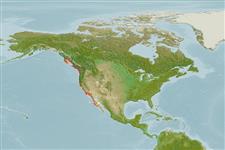Teleostei (teleosts) >
Gobiiformes (Gobies) >
Gobiidae (Gobies) > Gobionellinae
Etymology: ios: From the Latin ios, meaning 'arrow' (Ref. 27436).
Eponymy: Daniel Cleveland (1838–1929) was a founding partner and President of the San Diego Society of Natural History. He was honoured because he had: “…done much towards making known the fauna and flora of Southern California”. (Ref. 128868), visit book page.
More on authors: Jordan & Gilbert.
Environment: milieu / climate zone / depth range / distribution range
Ecology
Marine; brackish; demersal; depth range 0 - 2 m (Ref. 96339). Subtropical; 55°N - 22°N, 136°W - 111°W
Eastern Pacific: Rivers Inlet, British Columbia, Canada to Baja California, Mexico.
Size / Weight / Age
Maturity: Lm ? range ? - 3.4 cm
Max length : 6.4 cm SL male/unsexed; (Ref. 27436); common length : 4.2 cm TL male/unsexed; (Ref. 12193); max. reported age: 3.00 years (Ref. 72494)
Inhabits sand or mud bottom. Retreats into shrimp burrows when threatened and at low tide (Ref. 6885). Commonly in estuaries, lagoons and tidal sloughs. Reported to occur in freshwater. Adults feeds on diatoms, green algae, tintinnids, eggs and young of their hosts (Ref. 6885). Positions large food particles near crabs to be torn to smaller pieces (Ref. 6885). Preyed upon by Sebastes, staghorn sculpin, whitespot greenling, and terns (Ref. 6885). Unlike other gobies, it does not build a nest or care for its young (Ref. 2850).
Eschmeyer, W.N., E.S. Herald and H. Hammann, 1983. A field guide to Pacific coast fishes of North America. Boston (MA, USA): Houghton Mifflin Company. xii+336 p. (Ref. 2850)
IUCN Red List Status (Ref. 130435: Version 2025-1)
Threat to humans
Harmless
Human uses
Fisheries: commercial; aquarium: public aquariums
Tools
Special reports
Download XML
Internet sources
Estimates based on models
Preferred temperature (Ref.
123201): 9.4 - 18.5, mean 10.8 °C (based on 189 cells).
Phylogenetic diversity index (Ref.
82804): PD
50 = 1.0000 [Uniqueness, from 0.5 = low to 2.0 = high].
Bayesian length-weight: a=0.00977 (0.00444 - 0.02153), b=3.04 (2.85 - 3.23), in cm total length, based on LWR estimates for this (Sub)family-body shape (Ref.
93245).
Trophic level (Ref.
69278): 3.1 ±0.42 se; based on food items.
Resilience (Ref.
120179): High, minimum population doubling time less than 15 months (tm=1; tmax=2.5).
Fishing Vulnerability (Ref.
59153): Low vulnerability (10 of 100).
🛈
